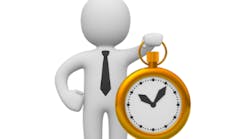How to increase efficiency in your dental practice
Efficiency is a mindset and should become part of your practice culture. Doing something in less time does not mean running around like chickens or not spending enough time with patients. We need to learn the art of time with our patients. Focusing on a conversation with a patient rather than multitasking while they’re in your chair is one example. Also, most patients would prefer a fewer number of visits to your office, so making the most of each appointment is good practice.
Being prepared for any possibility allows your team to feel confident. Having enough tray setups for any opportunity that presents itself is a good start toward efficiency. Cross-training your team allows them to shine, and being prepared equals efficiency.
When the practice culture is to offer patients complete exams, it moves the practice away from patching and emergency care. There is a reason patients come to your practice, and most want to know you have a plan of care in place for them. They still have a choice about when to pursue treatment. To add to the efficiency, at the end of every appointment, team members should ask the dentist, “Is there anything else we can do at the next appointment?” This maximized every appointment.
ALSO BY DRS. BLATCHFORD:
The family dental practice—Are you ready for two?
The advantages of starting a private dental practice
Want more new patients? What dentist doesn't? What 'senior' dentists might be selling?
Combining treatments can be a measure of efficiency. Always combine crown prep and endo or any other treatment. If there are fillings and a crown, do the fillings first and you will complete the crown prep in the allotted time. This works well with CAD/CAM as there is downtime available during milling and baking time.
In hygiene, collect the fee at time of service. Patients love this like the connection with their hygienist. This eliminates a line at the front desk, and allows the front desk more time for phone conversations. Clinically, encourage hygienists to do full mouth debridement at one appointment. This saves them time and the result is a more healthy mouth.
Become completely paperless. Operating two systems is a waste of time. New patient forms should be on your website and all patient records should be digital. To become paperless, start one day at a time, and don’t spend time inputting people into the digital records who have not visited the office yet.
Efficiency should start on the phone by having the front desk ask questions to eliminate the 30-minute “look and see” emergency appointment. With the patient records on your computer, ask, for example, “Is this broken tooth one the doctor had already recommended for a crown?” From the records, ask if there are any more previously diagnosed teeth in the same quadrant that need treatment. Ask, “Would you like to have all three of these taken care of at the same time? I can make arrangements for that.”
Practicing phone scripts for different scenarios that occur in your office regularly saves a lot of time for the dentist and patient. Phone training is a big part of making days efficient and profitable.
Timing your procedures is a great way to evaluate efficiency. We have learned many lessons from efficient assistants. We have what we call Ruth’s Rule. It’s a tribute to one of our fine assistants. It states, “Use one bur or instrument, do what you need to do, and move on. That bur or that instrument does not get revisited for that patient appointment.”
Scheduling in blocks has a profound effect on efficiency and profit. For example, booking similar procedures at the same time eliminates the team shifting gears both mentally and physically. Blocks of two hours with a production goal forces the team to focus on better scheduling. For example, if your goal for each two-hour block is $3K, there should be no “look-see” appointments during this time. When you produce $6K in the morning, you’re on the track to efficiency and more time away from the office to rejuvenate.

